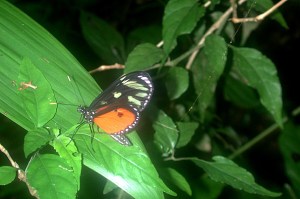Tag: Organisms
-
Health
Constant temps key to biodiversity
New paper answers the long-standing scientific question about cause of tropics’ stunning biodiversity.

-
Science & Tech
Scientists explore nature’s designs
As a graduate student, Harvard physical chemist Joanna Aizenberg acquired a passionate curiosity about — of all things — sponges. She particularly liked the ones made of glass, whose apparent fragility belied the fact that they could withstand terrific pressure in the deep sea.
-
Health
A single gene leads yeast cells to cooperate against threats
An ingenious social behavior that mobilizes yeast cells to cooperate in protecting each other from stress, antibiotics, and other dangers is driven by the activity of a single gene, scientists report this week in the journal Cell. The cooperating cells use the same gene, dubbed FLO1, as a marker for detecting “cheaters,” cells that try…
-
Campus & Community
The pine beetle’s tale: Destructive insect has pharmaceutical potential
Researchers at Harvard Medical School and the University of Wisconsin, Madison, have discovered how beetles and bacteria form a symbiotic and mutualistic relationship — one that ultimately results in the destruction of pine forests. In addition, they’ve identified the specific molecule that drives this whole phenomenon.
-
Campus & Community
Translating the color code
From snail shells to bird feathers to the changing skin of a chameleon, nature uses colors in ways that range from the electric blue of a poison dart frog’s warning to the invisible ultraviolet patterns of flowers that call bees to pollinate. The development, use, and perception of color is the subject of a new…
-
Health
Potent new strategy for mapping animal species shakes up tree of life
Since the 1859 publication of Charles Darwin’s “Origin of Species,” efforts to trace evolutionary relationships among different classes of organisms have largely relied on external morphological observations.
-
Arts & Culture
Taxonomist Carl Linnaeus on show at HMNH
Carl Linnaeus believed that the fruit of the Tree of Knowledge was not an apple but a banana. He came to this conclusion in 1737, while studying plant specimens at Hartecamp, the estate of George Clifford, a wealthy Dutch banker and director of the Dutch East India Company. Clifford collected exotic plants from around the…
-
Arts & Culture
Taxonomist Carl Linnaeus on show at HMNH
Carl Linnaeus believed that the fruit of the Tree of Knowledge was not an apple but a banana. He came to this conclusion in 1737, while studying plant specimens at Hartecamp, the estate of George Clifford, a wealthy Dutch banker and director of the Dutch East India Company. Clifford collected exotic plants from around the…
-
Health
‘Speed limit’ found on rate of evolution
Harvard University scientists have identified a virtual “speed limit” on the rate of molecular evolution in organisms, and the magic number appears to be six mutations per genome per generation — a rate of change beyond which species run the strong risk of extinction as their genomes lose stability.
-
Campus & Community
Aizenberg named McKay Professor of Materials Science
Joanna Aizenberg, a leader in the analysis of unique biomaterials that have evolved to carry out multiple functions in some organisms, has been appointed Gordon McKay Professor of Materials Science in Harvard University’s Faculty of Arts and Sciences and its School of Engineering and Applied Sciences (SEAS), effective July 1, 2007.


